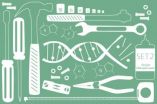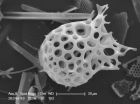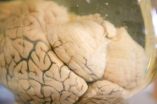(Press-News.org) CHAPEL HILL, N.C. – Twelve years ago, UNC School of Medicine researcher Brian Strahl, PhD, found that a protein called Set2 plays a role in how yeast genes are expressed – specifically how DNA gets transcribed into messenger RNA. Now his lab has found that Set2 is also a major player in DNA repair, a complicated and crucial process that can lead to the development of cancer cells if the repair goes wrong.
"We found that if Set2 is mutated, DNA repair does not properly occur" said Strahl, a professor of biochemistry and biophysics. "One consequence could be that if you have broken DNA, then loss of this enzyme could lead to downstream mutations from inefficient repair. We believe this finding helps explain why the human version of Set2 – which is called SETD2 – is frequently mutated in cancer."
The finding, published online June 9 in the journal Nature Communications, is the first to show Set2's role in DNA repair and paves the way for further inquiry and targeted approaches to treating cancer patients.
In previous studies, including recent genome sequencing of cancer patients, human SETD2 has been implicated in several cancer types, especially in renal cell carcinoma – the most common kind of kidney cancer. SETD2 plays such a critical role in DNA transcription and repair that Strahl is now teaming up with fellow UNC Lineberger Comprehensive Cancer Center members Stephen Frye, PhD, director of the UNC Center for Integrative Chemical Biology and Drug Discovery (CICBDD), Jian Jin, PhD, also with the CICBDD, and Kim Rathmell, MD, PhD, an associate professor in the department of genetics. Their hope is to find compounds that can selectively kill cells that lack SETD2. Such personalized medicine is a goal of cancer research at UNC and elsewhere.
In recent years, scientists have discovered the importance of how DNA is packaged inside nuclei. It is now thought that the "mis-regulation" of this packaging process can trigger carcinogenesis. This realm of research is called epigenetics, and at the heart of it is chromatin – the nucleic acids and proteins that package DNA to fit inside cells.
Proper packaging allows for proper DNA replication, prevents DNA damage, and controls how genes are expressed. Typically, various proteins tightly regulate how these complex processes happen, including how specific enzyme modifications occur during these processes. Some proteins are involved in turning "on" or turning "off" these modifications. For instance, protein and DNA modifications involved in gene expression in kidneys must at some point be turned off.
In 2002, Strahl found that Set2 in yeast played a role as an off switch in gene expression – particularly when DNA is copied to make RNA. Now, Strahl's team found that Set2 also regulates how the broken strands of DNA – the most severe form of DNA damage in cells – are repaired. If DNA isn't repaired correctly, then that can result in disastrous consequences for cells, one of them being increased mutation that can lead to cancer.
Through a series of biochemical and genetic experiments, Deepak Jha, a graduate student in Strahl's lab, was able to see what happens when cells experience a break in the double-strand of DNA.
"We found that Set2 is required when cells decide how to repair the break in DNA," said Jha, the first author of the Nature Communications paper. He said that the loss of Set2 keeps the chromatin in a more open state – not as compact as normal. This, Strahl said, leaves the DNA at greater risk of mutation. "This sort of genetic instability is a hallmark of cancer biology," Jha said.
Strahl and Jha said they still don't know the exact mechanism by which Set2 becomes mutated or why its mutation affects its function. But that's the subject of their next inquiry. They are now collaborating with Rathmell and Ian Davis, also members of UNC Lineberger Comprehensive Cancer Center, to study how the human protein SETD2 is regulated and how its mutation contributes to cancer.
Strahl said, "We think this work will lead to a greater understanding of cancer biology, and open the door to future therapeutic approaches for patients in need of better treatment options."
INFORMATION:
This research was funded through a grant from the National Institutes of Health.
UNC researchers pinpoint new role for enzyme in DNA repair, kidney cancer
The discovery, from the lab of Brian Strahl, Ph.D., offers insights for the creation of better, more targeted therapies for various forms of cancer
2014-06-09
ELSE PRESS RELEASES FROM THIS DATE:
Did violence shape our faces?
2014-06-09
(Salt Lake City) —What contributed to the evolution of faces in the ape-like ancestors of humans?
The prehistoric version of a bar fight —over women, resources and other slug-worthy disagreements, new research from the University of Utah scheduled for publication in the journal Biological Reviews on June 9 suggests.
University of Utah biologist David Carrier and Michael H. Morgan, a University of Utah physician, contend that human faces —especially those of our australopith ancestors — evolved to minimize injury from punches to the face during fights between males. ...
Iron supplements improve anemia, quality of life for women with heavy periods
2014-06-09
A study by researchers from Finland found that diagnosis and treatment of anemia is important to improve quality of life among women with heavy periods. Findings published in Acta Obstetricia et Gynecologica Scandinavica, a journal of the Nordic Federation of Societies of Obstetrics and Gynecology, suggest clinicians screen for anemia and recommend iron supplementation to women with heavy menstrual bleeding (menorrhagia).
One of the common causes of iron deficiency and anemia is heavy bleeding during menstration. Over time monthly mentrual iron loss without adequate ...
Most breast cancer patients may not be getting enough exercise
2014-06-09
Physical activity after breast cancer diagnosis has been linked with prolonged survival and improved quality of life, but most participants in a large breast cancer study did not meet national physical activity guidelines after they were diagnosed. Moreover, African-American women were less likely to meet the guidelines than white women. Published early online in CANCER, a peer-reviewed journal of the American Cancer Society, the findings indicate that efforts to promote physical activity in breast cancer patients may need to be significantly enhanced.
The US Department ...
Longer telomeres linked to risk of brain cancer
2014-06-08
New genomic research led by UC San Francisco (UCSF) scientists reveals that two common gene variants that lead to longer telomeres, the caps on chromosome ends thought by many scientists to confer health by protecting cells from aging, also significantly increase the risk of developing the deadly brain cancers known as gliomas.
The genetic variants, in two telomere-related genes known as TERT and TERC, are respectively carried by 51 percent and 72 percent of the general population. Because it is somewhat unusual for such risk-conferring variants to be carried by a majority ...
New molecule enables quick drug monitoring
2014-06-08
Monitoring the drug concentration in patients is critical for effective treatment, especially in cases of cancer, heart disease, epilepsy and immunosuppression after organ transplants. However, current methods are expensive, time-consuming, and require dedicated personnel and infrastructure away from the patient. Publishing in Nature Chemical Biology, scientists at EPFL introduce novel light-emitting sensor proteins that can quickly and simply show how much drug is in a patient's bloodstream by changing the color of their light. The method is so simple that it could be ...
Retracing early cultivation steps: Lessons from comparing citrus genomes
2014-06-08
Citrus is the world's most widely cultivated fruit crop. In the U.S. alone, the citrus crop was valued at over $3.1 billion in 2013. Originally domesticated in Southeast Asia thousands of years ago before spreading throughout Asia, Europe, and the Americas via trade, citrus is now under attack from citrus greening, an insidious emerging infectious disease that is destroying entire orchards. To help defend citrus against this disease and other threats, researchers worldwide are mobilizing to apply genomic tools and approaches to understand how citrus varieties arose and ...
Warming climates intensify greenhouse gas given out by oceans
2014-06-08
Rising global temperatures could increase the amount of carbon dioxide naturally released by the world's oceans, fuelling further climate change, a study suggests.
Fresh insight into how the oceans can affect CO2 levels in the atmosphere shows that rising temperatures can indirectly increase the amount of the greenhouse gas emitted by the oceans.
Scientists studied a 26,000-year-old sediment core taken from the Gulf of California to find out how the ocean's ability to take up atmospheric CO2 has changed over time.
They tracked the abundance of the key elements silicon ...
Study reveals rats show regret, a cognitive behavior once thought to be uniquely human
2014-06-08
New research from the Department of Neuroscience at the University of Minnesota reveals that rats show regret, a cognitive behavior once thought to be uniquely and fundamentally human.
Research findings were recently published in Nature Neuroscience.
To measure the cognitive behavior of regret, A. David Redish, Ph.D., a professor of neuroscience in the University of Minnesota Department of Neuroscience, and Adam Steiner, a graduate student in the Graduate Program in Neuroscience, who led the study, started from the definitions of regret that economists and psychologists ...
A tiny molecule may help battle depression
2014-06-08
Levels of a small molecule found only in humans and in other primates are lower in the brains of depressed individuals, according to researchers at McGill University and the Douglas Institute. This discovery may hold a key to improving treatment options for those who suffer from depression.
Depression is a common cause of disability, and while viable medications exist to treat it, finding the right medication for individual patients often amounts to trial and error for the physician. In a new study published in the journal Nature Medicine, Dr. Gustavo Turecki, a psychiatrist ...
Targeting tumors using silver nanoparticles
2014-06-08
(Santa Barbara, Calif.) — Scientists at UC Santa Barbara have designed a nanoparticle that has a couple of unique — and important — properties. Spherical in shape and silver in composition, it is encased in a shell coated with a peptide that enables it to target tumor cells. What's more, the shell is etchable so those nanoparticles that don't hit their target can be broken down and eliminated. The research findings appear today in the journal Nature Materials.
The core of the nanoparticle employs a phenomenon called plasmonics. In plasmonics, nanostructured metals such ...
LAST 30 PRESS RELEASES:
Interaction of climate change and human activity and its impact on plant diversity in Qinghai-Tibet plateau
From addressing uncertainty to national strategy: an interpretation of Professor Lim Siong Guan’s views
Clinical trials on AI language model use in digestive healthcare
Scientists improve robotic visual–inertial trajectory localization accuracy using cross-modal interaction and selection techniques
Correlation between cancer cachexia and immune-related adverse events in HCC
Human adipose tissue: a new source for functional organoids
Metro lines double as freight highways during off-peak hours, Beijing study shows
Biomedical functions and applications of nanomaterials in tumor diagnosis and treatment: perspectives from ophthalmic oncology
3D imaging unveils how passivation improves perovskite solar cell performance
Enriching framework Al sites in 8-membered rings of Cu-SSZ-39 zeolite to enhance low-temperature ammonia selective catalytic reduction performance
AI-powered RNA drug development: a new frontier in therapeutics
Decoupling the HOR enhancement on PtRu: Dynamically matching interfacial water to reaction coordinates
Sulfur isn’t poisonous when it synergistically acts with phosphine in olefins hydroformylation
URI researchers uncover molecular mechanisms behind speciation in corals
Chitin based carbon aerogel offers a cleaner way to store thermal energy
Tracing hidden sources of nitrate pollution in rapidly changing rural urban landscapes
Viruses on plastic pollution may quietly accelerate the spread of antibiotic resistance
Three UH Rainbow Babies & Children’s faculty elected to prestigious American Pediatric Society
Tunnel resilience models unveiled to aid post-earthquake recovery
Satellite communication systems: the future of 5G/6G connectivity
Space computing power networks: a new frontier for satellite technologies
Experiments advance potential of protein that makes hydrogen sulfide as a therapeutic target for Alzheimer’s disease
Examining private equity’s role in fertility care
Current Molecular Pharmacology achieves a landmark: real-time CiteScore advances to 7.2
Skeletal muscle epigenetic clocks developed using postmortem tissue from an Asian population
Estimating unemployment rates with social media data
Climate policies can backfire by eroding “green” values, study finds
Too much screen time too soon? A*STAR study links infant screen exposure to brain changes and teen anxiety
Global psychiatry mourns Professor Dan Stein, visionary who transformed mental health science across Africa and beyond
KIST develops eco-friendly palladium recovery technology to safeguard resource security
[Press-News.org] UNC researchers pinpoint new role for enzyme in DNA repair, kidney cancerThe discovery, from the lab of Brian Strahl, Ph.D., offers insights for the creation of better, more targeted therapies for various forms of cancer






